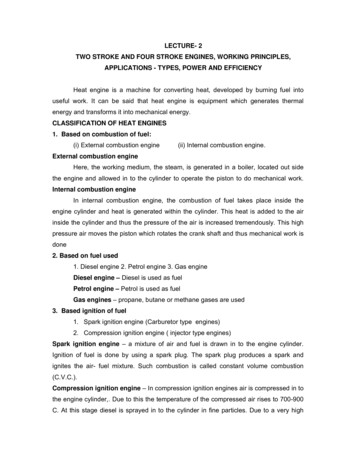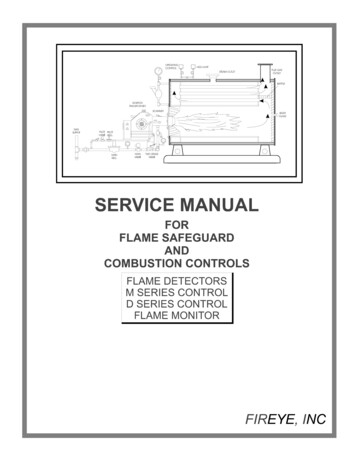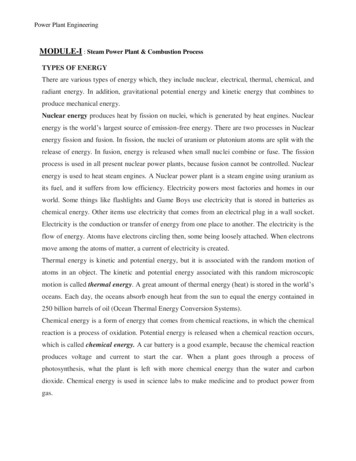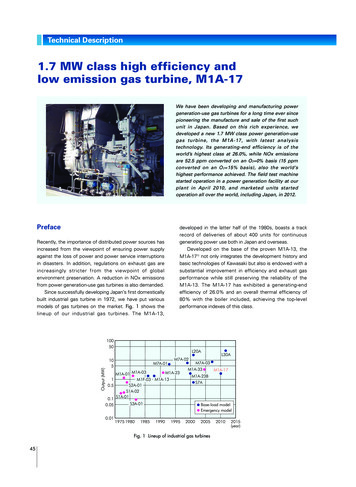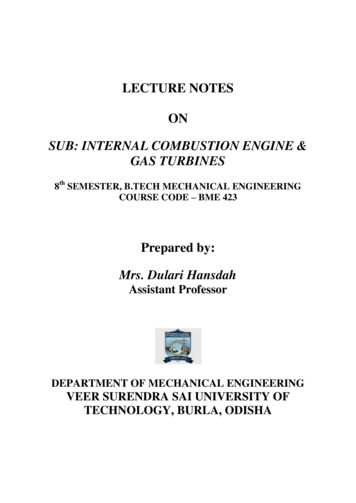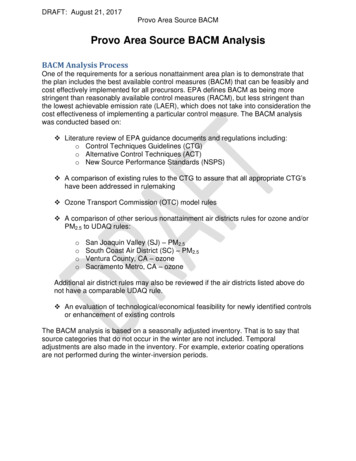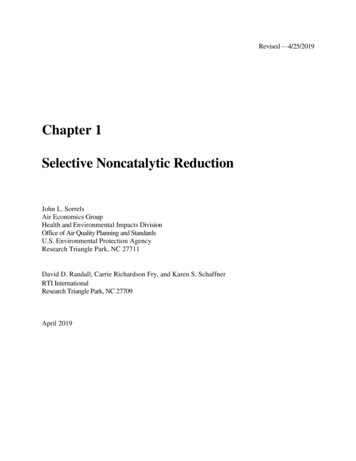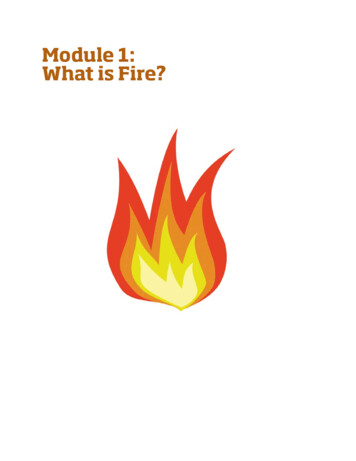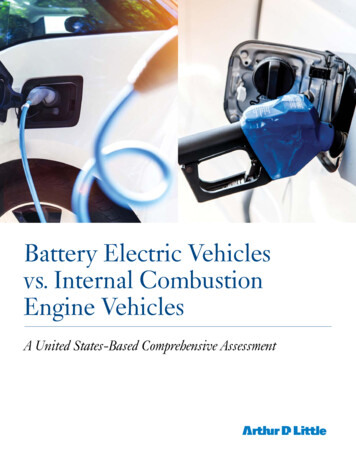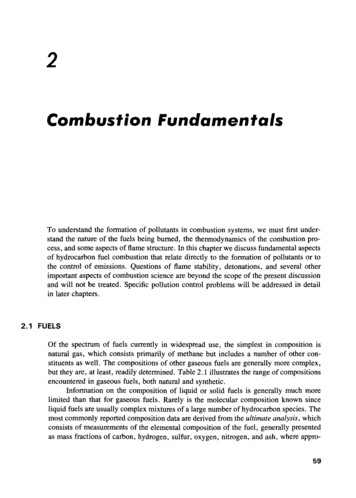
Transcription
2Combustion FundamentalsTo understand the fonnation of pollutants in combustion systems, we must first understand the nature of the fuels being burned, the thennodynamics of the combustion process, and some aspects of flame structure. In this chapter we discuss fundamental aspectsof hydrocarbon fuel combustion that relate directly to the fonnation of pollutants or tothe control of emissions. Questions of flame stability, detonations, and several otherimportant aspects of combustion science are beyond the scope of the present discussionand will not be treated. Specific pollution control problems will be addressed in detailin later chapters.2.1 FUELSOf the spectrum of fuels currently in widespread use, the simplest in composition isnatural gas, which consists primarily of methane but includes a number of other constituents as well. The compositions of other gaseous fuels are generally more complex,but they are, at least, readily detennined. Table 2.1 illustrates the range of compositionsencountered in gaseous fuels, both natural and synthetic.Infonnation on the composition of liquid or solid fuels is generally much morelimited than that for gaseous fuels. Rarely is the molecular composition known sinceliquid fuels are usually complex mixtures of a large number of hydrocarbon species. Themost commonly reported composition data are derived from the ultimate analysis, whichconsists of measurements of the elemental composition of the fuel, generally presentedas mass fractions of carbon, hydrogen, sulfur, oxygen, nitrogen, and ash, where appro59
enoTABLE 2.1PROPERTIES OF GASEOUS FUELSNatural gasNo. 1No.2 bNo.3No.4Refinery gasNo. 1No.2No. 3Coke oven gasBlast furnace gasCH 4C 2 H6C 3 71.82.041.64.315.920.982.75.019.713.0"p, 101 kPa; T, 25 C.b"Sweetened," H2S removed.COH2N2CO 53.47.00.000415.62.435.3H2 SHeatingvalue"(106 Jm- 3 )2.214.36.326.250.953.03.28.43.457.6
Sec. 2.1TABLE 2.2Fuels61PROPERTIES OF TYPICAL LIQUID FUELSAshSpecificgravityHeatingvalue(106 J 543.442.5Percent by weightGasolineCHN0Kerosene (No. 1)Fuel 0.50.10.30.50.10.40.4S0.10.4-0.7 2 2.8priate. The heating value, a measure of the heat release during complete combustion, isalso reported with the ultimate analysis. Ultimate analyses of a number of liquid fuelsare presented in Table 2.2.In addition to the limited composition data given in Tables 2.1 and 2.2, physicalproperties that influence the handling and use of a particular fuel are frequently measured. For liquid fuels, the specific gravity or API gravity, * viscosity (possibly at severaltemperatures), flash point (a measure of the temperature at which the fuel is sufficientlyvolatile to ignite readily), and distillation profiles (fraction vaporized as a function oftemperature) may be reported.The properties of solid fuels vary even more widely than those of liquid fuels. Themost common solid fuel is coal. Formed by biological decomposition and geologicaltransformation of plant debris, coals are classified by rank, a measure of the degree towhich the organic matter has been transformed from cellulose. Low-rank fuels such aspeat or lignite have undergone relatively little change, whereas high-rank anthracite isnearly graphitic in structure. Low-rank fuels contain large amounts of volatile matterthat are released upon heating. High-rank fuels contain much more fixed carbon, whichremains after the volatiles are released.Solid fuels are characterized by the ultimate analysis and by the so-called proximate analysis, which identifies the degree of coalifaction of a solid fuel (Table 2.3).Coal samples that have been air dried are subjected to a number of standardized tests todetermine the amount of moisture inherent to the coal structure, the quantity of volatilematter released by the coal upon heating to 1200 K for several minutes, and the massof ash or noncombustible inorganic (mineral) impurities that remains after low temperature (700 to 1050 K) oxidation. The difference between the initial mass of coal and thesum of masses of moisture, volatile matter, and ash is called fixed carbon. The conditions of these standardized tests differ markedly from typical combustion environments,and the values reported in the proximate analysis do not necessarily represent yieldsactually encountered in practical combustors. This point is discussed in more detail inthe section on solid fuel combustion.*Degrees API [141.5j(specific gravity 16 Cjwater at 16 C) - 131.5].
OlNTABLE 2.3PROPERTIES OF SELECTED SOLID FUELSPercent by weightProximate analysisFuel (state)Meta-anthracite (RI)Anthracite (PA)Semianthracite (PA)Bituminous (PA)High-volatile bituminous(PA)(CO)(KY)(IL)Subbituminous (CO)Lignite (ND)Brown coal (Australia)Wood (Douglas fir, as received)Ultimate analysisSHeatingvalue(106 J 4.06.20.70.876.673.466.912.858.842.452.30
Sec. 2.2Combustion Stoichiometry632.2 COMBUSTION STOICHIOMETRYComplete oxidation of simple hydrocarbon fuels forms carbon dioxide (C0 2 ) from allof the carbon and water (H20) from the hydrogen, that is, for a hydrocarbon fuel withthe general composition CnH m,Even in the idealized case of complete combustion, the accounting of all species presentin combustion exhaust involves more than simply measuring the CO2 and H20. Sincefuels are burned in air rather than in pure oxygen, the nitrogen in the air may participatein the combustion process to produce nitrogen oxides. Also, many fuels contain elementsother than carbon, and these elements may be transformed during combustion. Finally,combustion is not always complete, and the effluent gases contain unburned and partiallyburned products in addition to CO 2 and H 2 0.Air is composed of oxygen, nitrogen, and small amounts of carbon dioxide, argon,and other trace species. Since the vast majority of the diluent in air is nitrogen, for ourpurposes it is perfectly reasonable to consider air as a mixture of 20.9% (mole basis) O2and 79.1 % (mole basis) N2 Thus for every mole of oxygen required for combustion,3.78 mol of nitrogen must be introduced as well. Although nitrogen may not significantlyalter the oxygen balance, it does have a major impact on the thermodynamics, chemicalkinetics, and formation of pollutants in combustion systems. For this reason it is usefulto carry the "inert" species along in the combustion calculations. The stoichiometricrelation for complete oxidation of a hydrocarbon fuel, CnH m, becomesThus for every mole of fuel burned, 4. 78( n m 14) mol of air are required and 4. 78( n m 14) m 14 mol of combustion products are generated. The molar fuel/air ratio forstoichiometric combustion is 1 I [4. 78( n m 14) ].Gas compositions are generally reported in terms of mole fractions since the molefraction does not vary with temperature or pressure as does the concentration (moles/unit volume). The product mole fractions for complete combustion of this hydrocarbonfuel arenm14)Yeo2 4.78(n YH20 4.78(n m14) ml4 ml4ml2YN2 3.78( n m 14)4.78(n m14) ml4
64Combustion FundamentalsChap. 2The large quantity of nitrogen diluent substantially reduces the mole fractions of thecombustion products from the values they would have in its absence.Example 2.1 Combustion of Octane in AirDetennine the stoichiometric fuel/air mass ratio and product gas composition for combustion of octane (C SH 1S ) in air.The overall stoichiometry isC SH 1S 12.5(Oz 3.78Nz)---- -8CO z 9H zO 47.25NzFor each mole of fuel burned, 59.75 mol of air is required. The molecular weight of octaneis 114. The fuel/air mass ratio for stoichiometric combustion is, therefore,12.5(32114 114 0.06623.78 x 28)1723 The total number of moles of combustion products generated is8 9 47.25 64.25Finally, the product gas composition is, on a mole fraction basis,8Yeo, - - 0.125 12.5%64.25YH,OYN,964.2 --5 0.140 14.0% 47.25 0.735 73.5%64.25Minor components and impurities in the fuel complicate our analysis of combustion products somewhat. Fuel sulfur is usually oxidized to form sulfur dioxide (802 ),(Even though there are cases where sulfur compounds involving higher oxidation statesof sulfur or reduced sulfur compounds are produced, it is a reasonable first approximation to assume that all of the fuel sulfur forms 802 ,) Upon combustion, organicallybound fuel-nitrogen is converted to both Nz and NO, with molecular nitrogen generallydominating. For the moment we shall assume that all of the fuel-nitrogen forms Nz.Ash, the noncombustible inorganic (mineral) impurities in the fuel, undergoes a numberof transformations at combustion temperatures, which will also be neglected for the timebeing, so that the ash will be assumed to be inert.For most common fuels, the only chemical information available is its elementalcomposition on a mass basis, as determined in the ultimate analysis. Before we canproceed with combustion calculations it is necessary to convert these data to an effectivemolar composition.Example 2.2 Coal CompositionConsider a Pittsburgh seam coal that contains 77.2% C, 5.2% H, 1.2% N, 2.6% S, 5.9%0, and 7.9% ash by weight. The ultimate analysis is generally reported on an "as received"basis, including the moisture in the chemical analysis. The molar composition may be de-
Sec. 2.2Combustion Stoichiometry65termined by dividing each of the mass percentages by the atomic weight of the constituent.For convenience in stoichiometric calculations, the composition is then normalized withrespect to carbon:wtElement%mol/IOO g77.212 5.2I 1.2 .;- 14 2.6 .;- 32 5.9 .;- 16 7.9CHNSoAsh6.435.200.08570.08120.369mol/mol C.;.;.;.;.;.;-6.436.436.436.436.436.431.00 0.808 0.013 0.013 0.057 1.23 g/mol CThe chemical formula that can be used to describe this particular coal is, thus,CHo.sosNo.OI3S0.01300.057The formula weight of the fuel, or, as written here, the mass per mole of carbon, includingash, isMf100g6.43 mol C --- g15.55-mol CThe combustion stoichiometry of this fuel must include the minor species, ash, andoxygen in the fuel. Making the simplifying assumptions described above, we may write thestoichiometry asCHo.sosNo.o13So.QlPO.057 a(Oz 3.78Nz ) -- COzO.404H zO 0.013S0 z (3.78awherea 10.808 -4- 0.0570.013 - - - 1.192The fuel/air mass ratio for stoichiometric combustion is15.55 g/mol C1.19(32 0.0948 3.78 x 28) g/mol CThe total number of moles of gaseous combustion products per mole of C isNT 1 0.404 0.013 4.504 5.921The species mole fractions in the combustion products are, therefore,IYeo, 5.921 0.169 16.9%0.404YH,O 5.921 0.068 6.82% 0.OO65)Nz
66Combustion Fundamentals0.013Yso, 5.921Chap. 2 0.00220 2200 ppm4.504YN, 5.921 0.761 76.1 %where the S02 mole fraction has been expressed as parts per million (ppm) on a mole (orvolume) basis, a common form for presenting data on minor species in the gas (recallSection 1.3).Few combustion systems are operated precisely at the stoichiometric conditionbecause of the difficulty of achieving such intimate mixing between fuel and air thatperfect conversion is attained. More commonly, combustors are operated with a marginfor error using more than the stoichiometric amount of air. The fuel/air ratio is used todefine the operating conditions of a combustor. Comparison of the two examples presented above shows that the fuel/air ratio required for complete combustion varies withfuel composition. Values ofthe fuel/air and air/fuel mass ratios for stoichiometric combustion of a variety of fuels are presented in Table 2.4. Because the mass ratios varywidely with fuel composition, they are not a convenient base for comparison of systemsburning different fuels.The stoichiometric condition is a logical reference point for comparison of systemsoperating on different fuels. Several normalized ratios are used in the combustion literature to overcome the ambiguity of the mass ratio. The equivalence ratio, cP, is definedas the fuel/air ratio normalized with respect to the stoichiometric fuel/air ratio,cP mf/ma(mf/ma)s(2.1)Alternatively, the stoichiometric ratio, A, is the air/fuel ratio normalized with respect tostoichiometric, that is,1(2.2)cPOther ratios that appear in the literature include the percent excess air [EA (A - 1)X 100 %] and the percent theoretical air ( TA A X 100 %). In reading the combustionTABLE 2.4MASS RATIOS FOR STOICHIOMETRIC COMBUSTIONFuelH,CH 4Kerosene Cn H 2nBenzene (coke)CharCarbonMethanol CH 30HMolarH/Cratio004210.504(mfl ma 513121110.8
Sec. 2.367Combustion Thermodynamicsliterature, one should be careful to ascertain which of the various terms is being usedsince neither names nor symbols have been fully standardized. The fuel/air equivalenceratio, 4 , will be used in this book unless otherwise stated.The mix of combustion products varies with the equivalence ratio. Combustionmay be complete under fuel-lean conditions (excess air, 4 l) with some oxygenremaining unreacted in the combustion products. The composition of the products offuel-lean combustion is, to a good approximation, determined by atom balances alone.Consider, for example, the combustion of methane at 4 0.85,2)CO 2 2H 20 ( 0.85 - 2 O2 CO 2 2H2 0 0.35302 8.89N22 x 3.780.85 N2The composition of the combustion products now includes 02:112. 4Ye02 -2- 0.0817 8.17%YH20 12.24 0.163216.3%0.353Y0 2 12.24 0.0288 2.88%8.89- 0726 72.6%YN 2 12.24.In some references, the combustion condition is not stated in terms of a fuel/air ratiobut, rather, in terms of the amount of oxygen in the combustion products (i.e., 2.9%O2 in this case).The problem of specifying the products of combustion is more complicated forfuel-rich combustion, 4 1, than for fuel-lean combustion. Since there is insufficientoxygen for complete combustion under fuel-rich conditions, some carbon monoxide,hydrogen, and possibly, unburned hydrocarbons remain in the combustion products.Thus there are at least five products present (CO, CO 2 , H2 , H20, N2 ), but only fourelemental balances are possible. An auxiliary condition based on thermodynamics orkinetics is needed to determine the exhaust composition. We now tum our attention tocombustion thermodynamics before returning to the question of product gas compositionin fuel-rich combustion.2.3 COMBUSTION THERMODYNAMICSSubstantial energy is released in a very short time when a fuel is burned, leading to adramatic temperature increase of the combustion gases. Temperatures in excess of 2000K are common in flames. It is the high temperature that allows rapid oxidation of hy-
68Combustion FundamentalsChap. 2drocarbons and carbon monoxide to carbon dioxide and water but also makes possiblethe oxidation of Nz to form nitric oxide. The temperature in the flame must be knownto consider the formation and control of pollutants.Thermodynamics provides us with good estimates of the flame temperature thatare needed not only to assess the combustion process itself but also to calculate theconcentrations of the many chemical species that play a role in the formation and destruction of pollutants. We begin our study of the combustion process with a brief reviewof the relevant thermodynamics.2.3.1 First Law of ThermodynamicsThe first law of thermodynamics states that the change in the total energy of a closedsystem of fixed mass and identity is equal to the heat transfer to the system from itssurroundings minus the work done by the system on its surroundings; that is, for aninfinitesimal change of state,dE oQ - oW(2.3 )The total energy of the system, E, includes the internal energy, U, the kinetic energy,and the potential energy. The energy is a property of the system that is independent ofthe path taken in going from one state to another. In contrast, the heat transfer, oQ, andthe work transfer, oW, for any change in the state of the system depend on the mannerin which the state of the system is changed. The change in the system energy is describedby a total differential, dE. Since the work and heat transfer depend on the path followedby the system, the 0 is used to indicate that these increments are not total differentials.For most systems of concern here, the kinetic and potential energy terms can be neglected, so we may express the system energy in terms of the internal energy, that is,dU oQ - oW(2.4 )Integrating over a finite change of state from state I to state 2, the first law for a closedsystem becomes(2.5)Only rarely in the consideration of combustion processes can we limit ourselvesto a fixed mass in a closed system. More generally, the fuel and air enter the combustionzone across certain boundaries, and combustion products are exhausted across otherboundaries. It is convenient, therefore, to derive an expression for the change in stateof a fixed volume in space, called a control volume, rather than a fixed mass.A control volume may be defined in terms of any volume in space in which onehas interest for a particular analysis. Figure 2.1 illustrates a control volume that is prescribed by a surface, S. We would like to derive an equation that describes the changein the properties of the control volume when a small increment of mass, om, crosses Sand enters the control volume. To do this, we first define a closed system that includesboth the material initially in the control volume, mass m, energy E}, and the incrementof mass to be added, om. The initial state of the combined system consists of the control
Sec. 2.3Combustion Thermodynamics69Figure 2.1 Schematic of mass addition toa control volume and related thennodynamic system. The control volume isenclosed by the dashed curve. The solidcurve denotes the closed system.volume with its initial mass and energy and the incremental mass. After om is added,the mass in the control volume is m om, and the energy in the control volume is E2 The first law for the change of state of the combined closed system may be written asE2(E 1 -e om) Q12 pv om- Wxl2where e denotes the energy/unit mass (called the mass specific energy) of om, v 1/ pis the mass specific volume, pv om is the work done on the combined system by theenvironment as the small volume is moved across the control volume surface, and Wx isany work other than that associated with that volume displacement. Overbars are usedto denote mass specific properties. Rearranging, we findE2-E1 e om pv om Q12 - Wxl2For a small increment of change of state, this becomesdE (e pv) om oQ - oWx(2.6)
Combustion Fundamentals70Chap. 2The extension to a number of mass increments is straightforward: simply sum overall mass flows entering and leaving from the control volume, considering the relevantproperties of each increment. The time rate of change of the energy in a control volumewith a number of entering and exiting mass flows may then be written" (ej pvj)fj-- "-d E .,u (ei pvi)fidtJ,out Q -I,mWx(2.7)where hand]; are the mass flow rates (mass per time) leaving or entering the controlvolume, Q is the rate of heat transfer to the system (energy per time), and Wx is the rateat which work is done by the system on its surroundings other than that associated withflows across the control volume boundary. As noted above, in the combustion applications of interest here we can generally neglect the kinetic and potential energy contributions to the total energy, giving-dU dt" --,ui,inwhere the mass specific enthalpy,fih iIi,-,,--,Uj,outfjh j Q - Wx(2.8)is defined ash Ii pv(2.9)The energy equation may also be written on a molar basis, that is,dudt fih i -i,inj,outfjh j Q-Wx(2.10)where h u pv denotes the molar specific enthalpy, and fi is the molar flow rate ofspecies i. We shall generally use the molar specific properties in our treatment of combustion systems.Let us apply the foregoing to analyze the chemical reactionaA bB ---- cC dDoccurring at steady state and constant pressure in the isothermal flow reactor illustratedin Figure 2.2. The feed and effluent flows are at their stoichiometric values.Applying the steady-state form of (2.10) to this system givescfhc(T1 ) dfhD(T1 )-afhA(T1 )-bfhB(T1 ) Qwhere no work is done by the combustion gases except that due to flows across theboundary, so Wx O. (The expansion work is already accounted for in the enthalpy.)The molar flow of A into the control volume is af, that of C is cf, and so on, and thetemperature is T 1 Dividing through by f yieldsThe heat transfer per mole that is required to maintain the process at a constant temperature, T TI is called the enthalpy of reaction, and is given the symbol l .hr(T1 ), that
Sec. 2.3Combustion ThermodynamicsAaf------ 71CI---- cfT1Bb f - - -.dfFigure 2.2 Isothermal steady flow reactor.is,(2.11)We see that the enthalpy of reaction is just the difference between the molar specificenthalpies of the products and reactants taking into account the stoichiometry of thereaction. To define the enthalpy of a species requires a reference state at which theenthalpy is taken to be zero. That reference state is arbitrary as long as a consistentreference state is used throughout the calculations. Generally, the reference temperatureand pressure are taken to be To 298 K and Po 1 atm 101 kPa, respectively. Itshould be noted, however, that some sources report thermodynamic data relative to otherreference temperatures or pressures. The chemical reference state is usually based on thepure elements in their predominant forms at To and Po, that is, C as solid graphite H as Hz gas N as N z gas· as Oz gas S as solid sulfuretc.The enthalpy of a compound relative to the reference states of its constituent elementsis the enthalpy of the reaction of these elemental species that form 1 mole of the compound. When evaluated for reactants and products at the same temperature, T, this quantity is called the enthalpy offormation. Thus the enthalpy of formation of water is theenthalpy of the reactionnamelyThe superscript denotes evaluation with respect to the chemical reference state. Bydefinition, the enthalpies of formation of the elemental reference compounds are zero,0
Combustion Fundamentals72Chap. 2that is,li. h;' c, li. h;' H2 li. h;' N2 li. h;' 02 0The enthalpy of a compound at any temperature may be written as the sum of theenthalpy of formation at the reference temperature and a sensible enthalpy term associated with the temperature change from the reference temperature to the desired temperature. Thus the enthalpy of species i at temperature T relative to the reference state is(2.12)The sensible enthalpy term may be evaluated as an integral over temperature of thespecific heat at constant pressure, cp (ah / aT)p, that is,h;(T) - h;(To ) [T cp,;(T') dT'JTo(2.13)The specific heat generally varies with temperature. If the range of temperature variationis large, as is commonly the case in combustion applications, one must account for thedependence of cp ,; on temperature. For the present purposes, it is sufficient to approximate the specific heat as a linear function of temperature,(2.14 )This approximate form allows calculation of the sensible enthalpy over the range oftemperatures commonly encountered in combustion calculations (i.e., 300 to 3000 K)within about 10%. Table 2.5 presents specific heats, enthalpies of formation, and additional data to which we shall refer later for species encountered in combustion problems. While the linear approximation to cp is sufficient for present purposes, tabulationsof thermodynamic data such as the JANAF Thermochemical Tables (Stull and Prophet,1971) should be used, in general, for more precise calculations.The first law of thermodynamics for a chemically reacting open system may nowbe written asUddt . }.outjj[hj(T) - hj(To ) li.h;j(To)] - ;L:/;[h;(T)I,m- hi(To ) li.h;;(To )] Q - Wx(2.15)If the chemical composition and thermodynamic properties of the fuel are known, (2.15)allows us to calculate temperature changes, heat transfer, or work performed in combustion systems.As an example, consider a steady-flow fumace buming a stoichiometric methaneair mixture. The combustion reaction is
Sec. 2.3TABLE 2.5INTEREST73Combustion ThermodynamicsAPPROXIMATE THERMODYNAMIC DATA FOR SPECIES OF COMBUSTIONcp a bT(J mol- J K - I)SpeciesCC(s)CHCH2CH 3CH 4CNCOCOSCO 2C2 HC2H2C2 H4C2 H4 OC 2 N2HHCHOHCNHCOHNOHN02HN0 2HN0 3H02H2H 2OH 20 2H2SH 2 SO4H 2SO 4NNHNH2NH 3NON0 2N0 3N2N 2HN 20N2 0 s OHO2NameCarbon, monatomicGraphite (ref.)MethylidineMethyleneMethylMethaneCyanoCarbon monoxideCarbonyI sulfideCarbon dioxideCCH radicalAcetyleneEthyleneEthylene oxideCyanogenHydrogen, monatomicFormaldehydeHydrogen cyanideFormylNitroxyl hydrideNitrous acid, cisNitrous acid, transNitric acid vaporHydroperoxylHydrogen (ref.)Water vaporHydrogen peroxideHydrogen sulfideSulfuric acid vaporSulfuric acid liquidNitrogen, monatomicImidogenAmidogenAmmoniaNitric oxideNitrogen dioxideNitrogen trioxideNitrogen (ref.)DiimideNitrous oxideDinitrogen pentoxideOxygen, monatomicHydroxylOxygen (ref.)tlhJ(298 K)(J 71,2300213,27282,16611,313249,55339,5200sO(298 K)(J mol-I K- I -0.00020.003090.00349
Combustion Fundamentals74TABLE 2.5(Continued)Cp(JS(l)S(s)S02S03t,h;(298 K)(J mol-I)NameSpecies03S(g)Chap. 2OzoneSulfur, gasSulfur, liquidSulfur, solid (ref.)Sulfur dioxideSulfur trioxide142,880279,3911,4250-297,269-396,333sO(298 K)(J mol- I K- I )239.166168.01935.36431.970248.468256.990 a bTmol 1 K 553-0.00040.009760.021910.005740.00877The energy equation becomesfCH.{[h(T2 )-h(To) Lih;(To)] C02 2[h(T2 ) 7.56[h(T2 )- 2[h(Tl )---h(To) Lih;(To)]HO2h(To) Lih;(To)] N2 - [h(Tl )-h(To) Lih;(To)]CH4h(To) LihfO(To)] 02 - 7.56[h(T]) - h(To) Lih;(To)] N2 }where T] and T2 are the temperatures of the reactants entering and the products leavingthe furnace, respectively. Wx has been set equal to zero since we are dealing with a heattransfer system in which no work is performed. Using thermodynamic data for all of thechemical species involved, the heat transfer rate can readily be computed.When the chemical composition of a fuel is not known, instead of using fundamental thermochemical data on the constituents, we must rely on the empirical characterization provided by the ultimate analysis. The enthalpy of the combustion reaction isreadily measured using a calorimeter, such as the flow calorimeter illustrated schematically in Figure 2.3.Fuel and air are introduced to the calorimeter at T] and Pl' The fuel is burnedcompletely, and the products are cooled to Tl The heat transfer required for this coolingis measured. Applying the first law, (2.8), at steady-state conditions in the absence ofany work performed yieldsWe have used the first law on a mass rather than a molar basis to be consistent with theway enthalpies of combustion are commonly measured and reported, since if the molecular structure of the fuel is not known, we cannot uniquely define the enthalpy of reactionon a molar basis. The heat released per unit mass of fuel burned is, however, readilydetermined, so enthalpy of combustion data are commonly reported on a mass specific
Sec. 2.3Combustion Thermodynamics75 - -eCooling waterin T W1Cooling waterout T w2Figure 2.3 Flow calorimeter.basis. We find the enthalpy of combustion of a unit mass of fuelQc -ffuel fp Oducts -hoproducts (T)Ififuel--ho (T)fuelI-fair -ho (T)fi -airI(2.16)fuelSince the combustion process is exothennic (releases heat), f1h c ( Td is negative. Forcombustion chemistry calculations, it is convenient to convert the mass specific enthalpyof combustion to a mole specific value using the fonnula weight, that is,(2.17)Flow calorimeter measurements of the heating value are usually perfonned at temperatures in the range 288 to 298 K, introducing a problem in the interpretation of theenthalpy of combustion. The measurement requires complete combustion; that is, allcarbon and hydrogen must be oxidized to fonn CO2 and H 20, respectively. If the calorimeter is operated near stoichiometric, the product gases may contain several percentH 2 0, considerably more than the saturation vapor pressure of water at that temperature.Hence water will condense in the calorimeter, increasing the apparent heat release
64 Combustion Fundamentals Chap. 2 The large quantity of nitrogen diluent substantially reduces the mole fractions of the combustion products from the values they would have in its absence. Example 2.1 Combustion ofOctane in Air Detennine the stoichiometric fuel/air mass ratio and product gas
